Contents
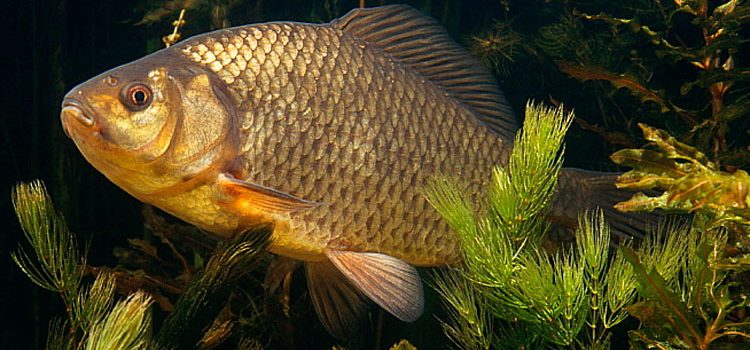
Carp is a fish that is found in almost all reservoirs where there is water. The crucian carp survives in conditions when other species of fish die. This is due to the fact that crucian carp can burrow into the silt and spend the winter in such conditions, being in a state of suspended animation. Carp fishing is an interesting activity. In addition, this fish has quite tasty meat, so many healthy and tasty dishes can be prepared from it.
Crucian: description, types

Crucian carp is a prominent representative of the carp family and the genus of the same name – the genus of crucians. The crucian carp has a high body, compressed from the sides. The dorsal fin is long and the back itself is thick. The body is covered with relatively large, smooth to the touch, scales. The color of the fish may vary slightly, depending on habitat conditions.
In nature, there are 2 types of carp: silver and gold. The most common species is silver carp. There is another species – decorative, which is artificially bred and is known to many aquarists under the name “goldfish”.
Goldfish
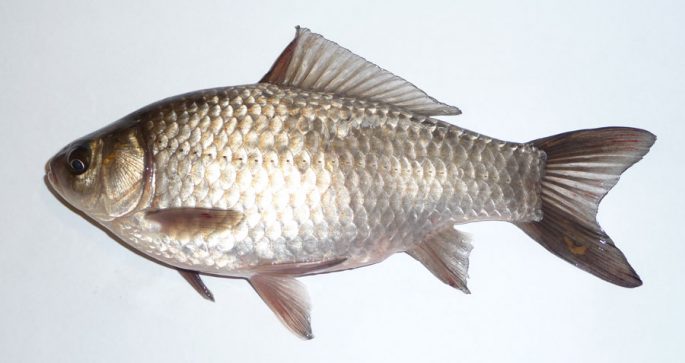
The silver carp outwardly differs from the golden carp, not only in the color of the scales, but also in the proportions of the body. Moreover, such differences largely depend on the habitat. If you look from the side, then the muzzle of the silver carp is somewhat pointed, while that of the golden carp, it is almost round. A distinctive feature is the shape of the dorsal and anal fins. The first ray of these fins looks like a hard spike, and quite sharp. The rest of the rays are soft and non-prickly. The caudal fin is well shaped. This type of carp is able to reproduce offspring by gynogenesis.
Golden crucian
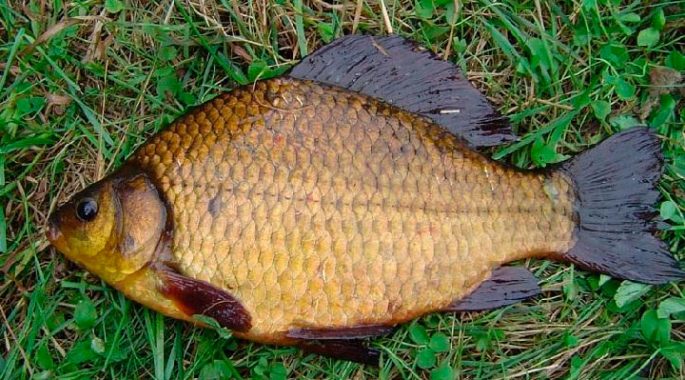
Golden or, as they are also called, ordinary crucians inhabit the same reservoirs as silver ones, while they are much less common. First of all, golden crucian differs in the color of the scales, which is distinguished by a golden hue. Golden crucians do not differ in impressive size. They also differ in that all fins are painted in dark brown colors. In this regard, silver carp with a golden hue is called silver carp, despite the fact that the fins have the same shade as the scales.
Distribution and habitats

Crucian carp is a fish that lives in almost all water bodies of all continents, although it originally lived in the Amur River basin. The crucian rather quickly, not without human intervention, spread to other Siberian and European water bodies. The resettlement of crucian carp occurs in our days, because it begins to settle in the waters of India and North America, as well as other regions. Unfortunately, the number of common carp (golden) is sharply declining, as the silver carp is replacing this species.
Crucian prefers to live in any reservoirs, both with stagnant water, and in conditions of the presence of a current. At the same time, for its life activity, it chooses water areas with a soft bottom and the presence of abundant aquatic vegetation. Crucian carp is caught in various reservoirs, as well as in the backwaters of rivers, in channels, in ponds, flooded quarries, etc. Crucian carp is a fish that is not demanding on the concentration of oxygen in the water, therefore it inhabits wetlands that can freeze to the very bottom in winter. The crucian prefers to lead a benthic lifestyle, as it finds food for itself at the bottom.
Age and size
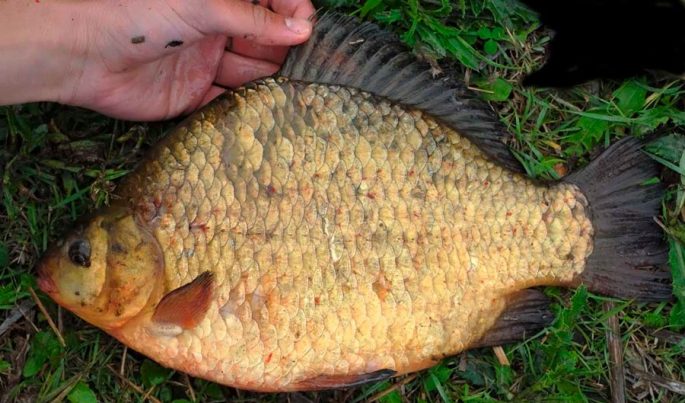
Common crucian carp (golden) grows in length up to half a meter, while gaining a weight of about 3 kg. Silver carp is more modest in size: it grows up to 40 cm in length, with a weight of no more than 2 kg. Such individuals are considered old. An adult fish of interest to the angler does not exceed a weight of 1 kg.
In small reservoirs, crucian carp gain weight no more than 1,5 kg, although if there is a good food supply, this value can be much larger.
Crucian carp becomes sexually mature, reaching the age of 3-5 years and gaining a weight of about 400 grams. In fact, most of the 3-year-old individuals reach a weight of no more than 200 grams. At the age of two, crucian carp has a length of about 4 cm. When the living conditions are quite comfortable and there is enough food, two-year-old individuals can weigh up to 300 grams.
Therefore, we can safely say that the size of the fish and its weight directly depend on the availability of food resources. Crucian feeds mainly on plant foods, therefore, in reservoirs where there is a sandy bottom and little aquatic vegetation, crucian carp grow rather slowly. Fish grow much faster if the reservoir contains not only plant food, but also animal food.
When crucian carp predominates in a reservoir, then small livestock are mainly found, although a slowdown in growth is also associated with other factors.
I caught a LARGE CARP at 5kg 450g!!! | The Biggest Fish Caught in the World
Life
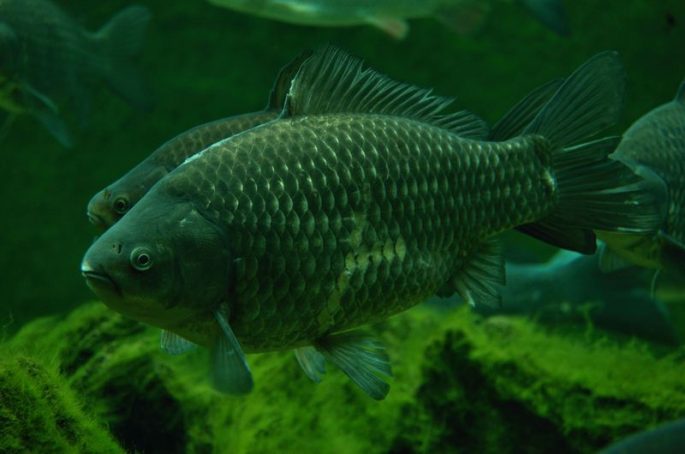
The difference between common carp and silver carp is insignificant, so it makes no sense to consider each species separately. Crucian carp is perhaps the most unpretentious fish, as it can live in all types of water bodies, both with stagnant and running water. At the same time, fish can be found in semi-underground reservoirs covered with bogs, as well as in small reservoirs where, except for crucian carp and rotan, no fish will survive.
The more mud in the reservoir, the better for the crucian, because in such conditions the crucian easily gets food for itself, in the form of organic residues, small worms and other particles. With the onset of winter, fish burrow into this silt and survive even in the most severe snowless winters, when the water freezes to the very bottom. There is evidence that carp were dug out of the mud from a depth of 0,7 meters absolutely alive. Moreover, this happened in the complete absence of water in the reservoir. Golden crucians are especially survivable, so it is almost impossible to find a reservoir, wherever this fish is found. Carp often find themselves in small ponds or lakes by accident, especially after the spring flood. At the same time, it is known that fish eggs are carried by waterfowl over considerable distances. This natural factor allows the crucian carp to settle in water bodies that are far from civilization. If the conditions for the development of crucian carp are quite comfortable, then after 5 years the reservoir will be full of crucian carp, although before that it (the reservoir) was considered fishless.
Carp is found in many water bodies, although to a lesser extent it is found in rivers and some lakes, which is due to the nature of the water body itself. At the same time, he can choose inlets, bays or backwaters, where there are a lot of algae and a muddy bottom, although the reservoir itself may be characterized by the presence of a sandy or rocky bottom. The crucian carp itself is quite clumsy and hard to cope with even the slowest current. Many predators take advantage of the sluggishness of this fish and can soon exterminate the entire population of crucian carp if it has nowhere to hide. At the same time, juveniles and eggs of fish suffer greatly. In addition, if the bottom is hard, then crucian carp will remain hungry and are unlikely to take root in such conditions.
Crucian carp is not afraid of cold water, as it is found in the Urals, as well as in pits at a considerable depth with spring water.
Spawning carp
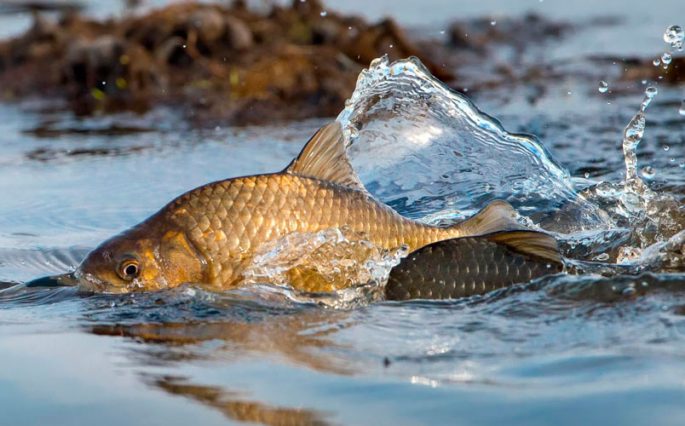
Spawning of crucian carp, depending on the habitat, begins in mid-May or early June. Often, already in mid-May, you can watch the mating games of fish not far from the coast. This is a signal for anglers, which indicates that the crucian carp is going to spawn and its biting may stop completely. During this period, crucian carp is not interested in food, although active bites are still observed in the first couple of days after the start of mating games. Therefore, the closer to the end of spring, the less chance of catching crucian carp, especially those that have reached puberty.
After spawning, caviar is actively eaten by green frogs and newts, which live in the same conditions as crucian carp. When crucian fry emerge from the remaining eggs, they fall prey to the same predators. Swimmers are large water beetles that also prey on young carp, although these hunters do not bring significant harm to the carp population. They regulate the number of fish in water bodies at the natural level.
Since crucian carp is characterized by sluggishness, it often becomes a victim of many underwater predators, including predatory fish. Crucian carp does not need speed of movement, especially if there is enough food for it. The crucian loves to burrow into the silt when one tail sticks out of the silt. So he gets food for himself, but at the same time he can become food for other predators, because he forgets about his safety. When it is warm or very hot outside, crucian carp move closer to coastal thickets of vegetation, especially early in the morning or late in the evening. Here it feeds on young shoots of aquatic vegetation, especially reeds.
The crucian hibernates, burrowing into the silt. At the same time, the depth of the reservoir affects the depth of immersion of crucian carp in the silt. The smaller the pond, the deeper the crucian burrows. So he spends the whole winter until the reservoir is completely clear of ice. After that, crucian carp can be found along the coastline, where aquatic plants predominate. The crucian comes out of their winter shelters shortly before spawning, when the water temperature rises noticeably, and the water begins to become cloudy and aquatic vegetation rises from the bottom. During this period, rose hips begin to bloom.
Fishing for carp! We tear red and CARP IS STUPID!
Catching crucian carp

Basically, crucian inhabits reservoirs with stagnant water, although it is also found in rivers, in conditions of a slight current. The number of golden carp is decreasing every year, but silver carp is found everywhere and in significant quantities.
As a rule, crucian bites are best in the early morning or late evening. After sunset, large crucian carp begin to fall on the bait, which is important for any angler. In a short period of time, during this period, you can catch larger carp and more than in a whole day. The place of fishing should be found more carefully, based on the knowledge of how crucian carp behave in specific conditions. Without knowing the habits of the fish, this is impossible to do.
If fishing is carried out on an ordinary float rod, then it is better to sit next to thickets of reeds or other aquatic vegetation. It is equally important that vegetation covering the bottom of the rate or pond is also present at the bottom of the reservoir. The depth difference in such places should be about half a meter. To lure crucian carp and keep it at the fishing point, feed, cake or boiled peas are suitable. At the same time, crucian carp can be caught on a fishing rod, on an elastic band or on a bottom tackle. As bait, you can use a worm, bloodworm, maggot or vegetable bait, in the form of pearl barley, dough, white bread crumb, etc.
Large carp can be seduced into pieces of “tulka”. Each bite is bold. After he grabs the bait, he tries to pull it to the side or to the depth. Since mostly small individuals are caught on the hook, then to catch it you will need sensitive tackle, with a hook No. 4-6, with a leash no more than 0,15 mm thick and a main line with a diameter of up to 0,25 mm. The main thing is that the float is sensitive. As a rule, a goose feather float has such characteristics. Often, crucian carp have rather cautious bites that require a quick reaction. Untimely hooking leaves the hook without a nozzle, and the angler without a catch.
Best biting period

Crucian bites well in the pre-spawning period, when the water warms up to 14 degrees. In general, in the summer they peck unevenly, capriciously, especially if there is a lot of natural food in the reservoir. They peck best in the morning, at sunrise, and in the evening when the heat of the day subsides.
Winter fishing
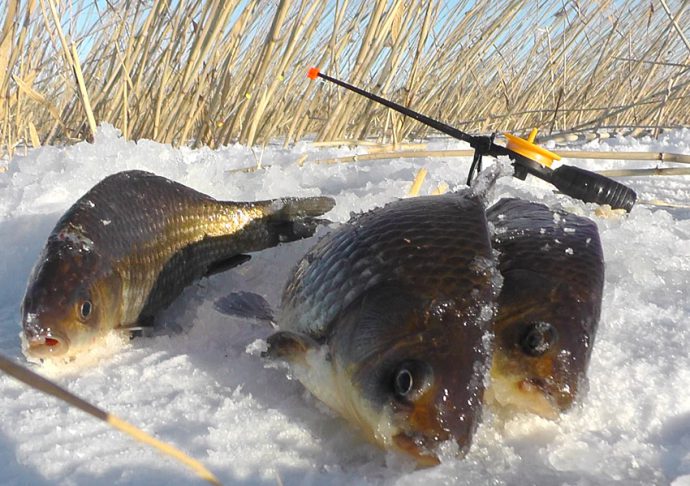
There are reservoirs where the crucian is active throughout the year, and there are reservoirs where the crucian does not lose its activity on the first and last ice. At the same time, the bulk of the reservoirs differ in that it is practically useless to catch crucian carp in such reservoirs in winter.
Smaller crucian carp burrow into the silt already at the beginning of December, and larger crucian carp still continue to move around the reservoir in search of food. Therefore, in winter, large crucian carp are mainly caught, weighing up to half a kilogram, or even more. The fish are most active in December and January, as well as in March with the first signs of the coming heat.
When the weather is too cold outside, the crucian goes to the depths, but for feeding it goes to smaller parts of the reservoir. Even in such conditions, crucian carp prefer to stay close to thickets of reeds or reeds. If there are predatory fish in the reservoir, we can safely say that crucian carp is found in this reservoir.
Carp, like other fish species, is quite sensitive to atmospheric pressure fluctuations. You can count on his capture on sunny windless days, but in conditions of blizzards, snowfalls or severe frosts, it is better not to go for crucian carp.
Catching carp in winter from the ice!
Catching carp in the spring
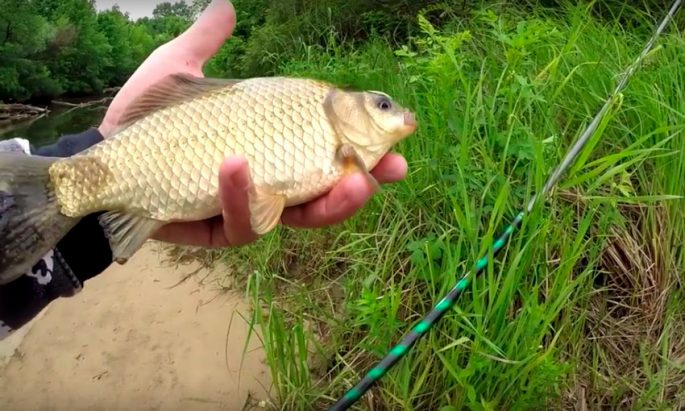
Spring is a favorable period for fishing for crucian carp. Already at a water temperature of +8 degrees, it becomes much more active, and when the water temperature rises to +15 degrees, crucian carp begins to actively take the bait. If warm spring weather has settled on the street, then its active biting can be observed already in March. Crucian begins to act up when the water temperature cannot be established at the proper level.
With the advent of spring, when aquatic vegetation has not yet begun to revive, large and small specimens can be found in different parts of the water area. If a small carp began to peck in one place, then it is better to look for another place where a flock of a larger carp stopped.
During this period, the fish chooses places for its parking, where the water warms up quickly. Carp also want to bask in areas in direct sunlight. Therefore, during this period, crucian carp is located in shallower areas overgrown with reeds, reeds or pondweed. In crucian carp, as in many other species of fish, pre-spawning and post-spawning zhor is noted. It is important to accurately determine these moments in the life of a crucian and then the catch can be very tangible.
Summer fishing
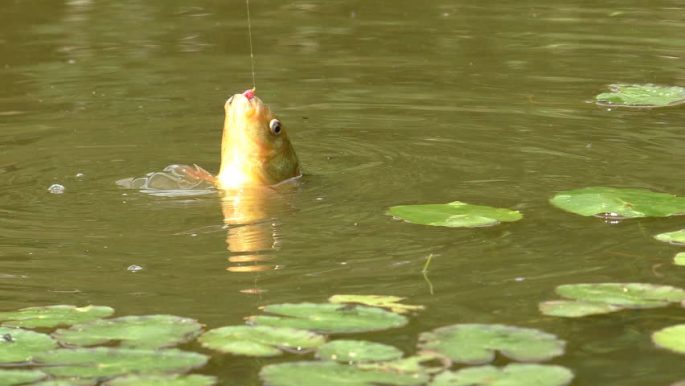
Catching carp in the summer is considered the most acceptable, despite the fact that there is already enough food for it in the pond. It is in summer that you can count on the catch of trophy specimens. In this case, it is necessary to pay attention to the weather conditions. If the weather is cold, rainy and windy, then you should not count on significant activity of crucian carp.
The first half of June is not so productive in terms of fishing, as the crucian still continues to spawn. During this period, crucian carp practically does not feed, and individuals that have not reached puberty come across on the hook. The uniqueness of crucian carp lies in the fact that it can spawn several times during the summer. Therefore, short-term bursts of activity and passivity are observed, which affects the biting of the fish. During the spawning period, when the real zhor is different, the crucian takes any bait.
In order for fishing to be successful, you need to be able to choose the right promising place. When the weather is hot outside, the crucian constantly migrates in search of shady places where you can hide from direct sunlight. In such conditions, carp should be looked for in the shade of trees hanging over the water, next to the coastline, overgrown with various vegetation. Here the fish can peck all day long. Where the surface of the water begins to bloom, there will be no crucian carp due to a severe lack of oxygen.
FISHING on CARP or 100% UNDERWATER SHOOTING on WILD POND
Autumn fishing for carp
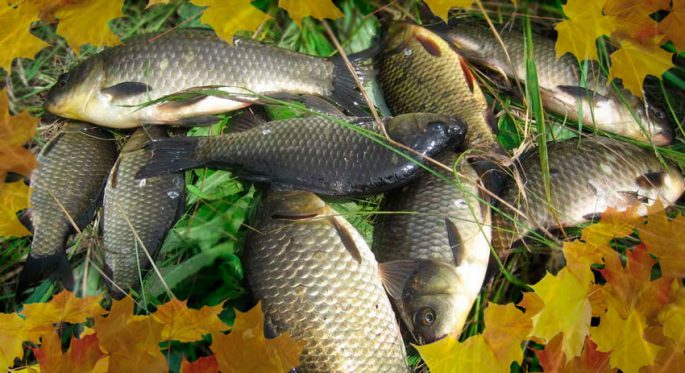
Fishing for crucian carp in the fall has some features. Due to the decrease in water temperature, as well as the gradual death of aquatic vegetation, which served as food for fish in summer, crucian carp leaves the shore to depths of 3 meters or more, where the water temperature is more stable.
In early autumn, crucian carp still visits places of constant feeding. This is especially true in warm autumn weather. As the water temperature drops, crucian carp constantly migrates around the reservoir, looking for more comfortable areas of the water area. There are reservoirs with a minimum depth, where crucian carp immediately burrow into the silt with the onset of cold weather, so it is not necessary to count on a catch in the fall in such conditions.
In reservoirs with significant differences in depth, crucian carp hibernates in deep pits, while it may not react at all to any kind of bait. Before the appearance of the first ice on the reservoir, a bite of crucian carp is still possible if you find a place for its parking.
Crucian can actively peck in cloudy, but warm weather with drizzling warm rain. Bursts of activity are also observed before a change in the weather. According to many anglers, the crucian starts pecking especially actively before a thunderstorm, during rain or snowfall, especially if the crucian is stocking up on nutrients.
In conclusion

Many anglers practice mainly catching crucian carp and are called “crucian fishermen”. This is due to the fact that crucian prevails in many rates, ponds, as well as other small water bodies where other fish simply cannot survive. In addition, catching crucian carp is a rather gambling and interesting activity, its meat is quite tasty, although bony. This is especially true of trifles, but having caught a trophy crucian carp, you can cook a rather tasty dish from it. To make it also useful, it is better to bake crucian carp in the oven. Fried crucian carp is no less tasty, but such a dish can only be eaten by healthy people who do not have problems with the gastrointestinal tract.
In any case, eating fish allows a person to regularly replenish his body with essential nutrients, such as vitamins and minerals. Moreover, in fish they are in an easily accessible form. Eating fish allows you to slow down the aging process, strengthen bone tissue, normalize skin, strengthen hair, etc. In other words, the presence of all the necessary compounds in fish allows a person to prevent the appearance of many ailments that are associated with a lack of vitamins and minerals.
In our time, crucian carp is perhaps the only fish that is found in ponds and in large quantities. Going fishing for crucian carp, you can be sure that you will always be able to catch it, in comparison with other types of fish, although there are reservoirs where, apart from crucian carp, there is no other fish. Although this does not guarantee that fishing will be successful. It is not known for what reasons, but sometimes the crucian refuses to take the most attractive baits.
Carp is found in almost any reservoir where there is water and enough food. And he will be able to overwinter, burrowing into the silt to a considerable depth.
Crucian description, lifestyle









